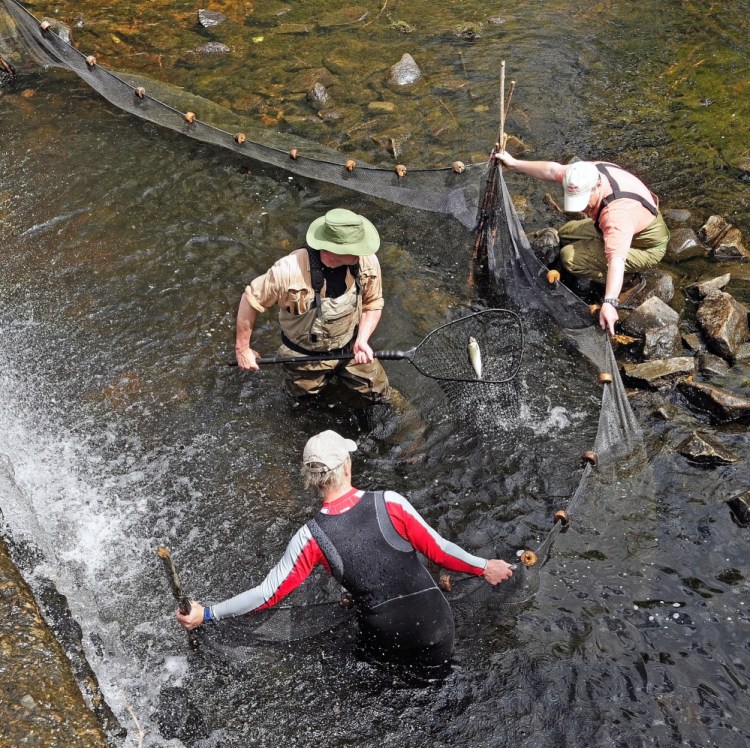AUGUSTA — City councilors expressed support for forming a committee to look into taking joint ownership of the dam that controls the water level on Togus Pond, but also expressed concern about taking on the corresponding potential responsibility and cost of operating and maintaining the dam.
The association of property owners on Togus Pond that owns and operates the dam is looking to give up its sole ownership and instead share responsibility for the dam with the municipalities of Augusta, Chelsea and possibly Randolph.
Association leaders made their pitch Thursday to the Augusta City Council and already have had initial discussions with town leaders in Chelsea, where the dam is located, and Randolph, through which Togus Stream runs on its way from the lake to the Kennebec River. The dam is used to control the water level on the body of water, which is surrounded by hundreds of homes and camps.
Most of the valuable real estate surrounding the pond is in Augusta. City Manager William Bridgeo said there are roughly 300 residences, as well as many nonresidential properties on the pond in the city, together making up a significant portion of the city’s property tax base.
City councilors and Mayor David Rollins expressed interest Thursday in forming a committee to look into the many unanswered questions about the proposal.
But multiple councilors expressed worries about the city becoming an owner of the dam.
“What’s made me a little nervous coming into this conversation is you read in the paper about problems and disputes in the maintenance of dams, and everybody points to someone else (as having responsibility) and turns their back,” said At-Large Councilor Mark O’Brien.
Bridgeo said he is not making a recommendation whether the city should take partial ownership of the dam in the proposed consortium.
“I have my own misgivings about the city assuming ownership,” he said, citing incidents in which dam operators elsewhere were blamed and sued for allegedly causing flooding, and operators were criticized by camp owners and homeowners for letting too much or too little water into lakes. “That said, we’re talking about hundreds of property owners who live around the lake or abut it and use it. And, typically, if there is something that benefits a large number of residents of the community, and they don’t have the ability to address it on their own, that’s a reasonable time for a government to step in and assist.”
The Worromontogus Lake Association has owned the dam, originally built in 1804, since 1932. The stone masonry and cast concrete dam was “substantially rebuilt” in the mid-1980s, according to association leaders, and a 2013 inspection deemed it to be in good condition. It is about 25 feet long and 7 feet high and there are plans, as yet unfunded, to build a fishway to allow passage of alewives past the dam to and from Togus Pond.
He said an association member maintains the dam now by checking it about once a week. That involves moving boards that hold back water, as needed, to control water flow in the stream below and the water level in the pond above.
But he said operating the dam will become more complex if and when a fishway is put in.
Gary Schaumburg, treasurer of the lake association, said the fishway project is primarily a project of the state Department of Marine Resources. He said the cost of building it would not fall on the proposed consortium partners.
The cost of operating the dam could be offset by potential revenue from selling licenses to fishermen, who net alewives and use them as bait, notably as lobster bait.
Jolda said that revenue could be used to help maintain and operate the dam, and even be a revenue source for the dam’s new potential municipal partners if they agree to take an ownership stake in the dam.
He said a similar situation on Webber Pond in Vassalboro has brought the town of Vassalboro “tens of thousands” of dollars in revenue.
Schaumburg said the cost of maintaining the dam now is “pretty minuscule.”
“But if something happens to it, it would need repairs,” he said. “Part of the reason for the consortium would be to spread the cost.”
Jolda said association officials have spoken to town officials in Randolph and Chelsea. He said Randolph officials seemed surprised by the proposal, while Chelsea officials seemed accepting toward it.
There are multiple examples of municipal ownership of dams in central Maine, including the Maranacook Lake Dam owned by Readfield and Winthrop, through an intra-local agreement; Cochnewagon Lake Dam by Monmouth; Cobbossee Lake Dam by Manchester; Tacoma Lakes Dam by Litchfield; New Mills Dam by Litchfield, Richmond and Gardiner; and Belgrade Lakes dams including Wings Mill Dam, Ellis Pond Dam, Messalonskee No. 2 Dam, and the Village Spillway, are owned via intra-local agreements involving Belgrade, Rome and Oakland.
Keith Edwards — 621-5647
Twitter: @kedwardskj
Send questions/comments to the editors.




Success. Please wait for the page to reload. If the page does not reload within 5 seconds, please refresh the page.
Enter your email and password to access comments.
Hi, to comment on stories you must . This profile is in addition to your subscription and website login.
Already have a commenting profile? .
Invalid username/password.
Please check your email to confirm and complete your registration.
Only subscribers are eligible to post comments. Please subscribe or login first for digital access. Here’s why.
Use the form below to reset your password. When you've submitted your account email, we will send an email with a reset code.